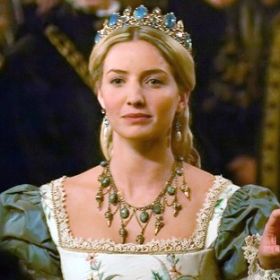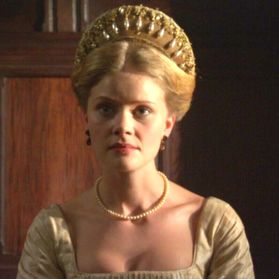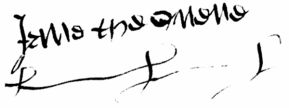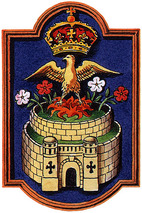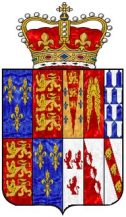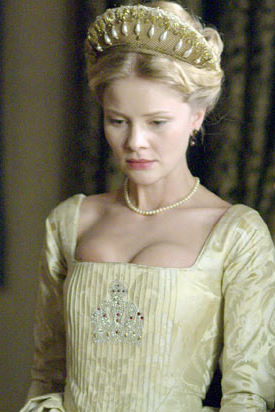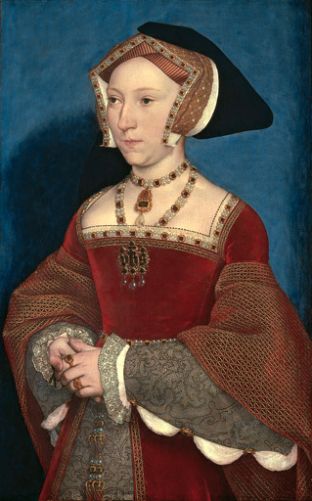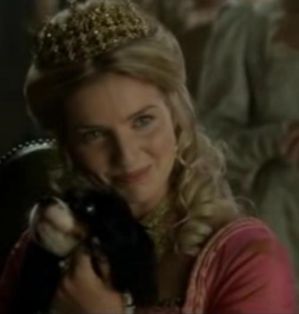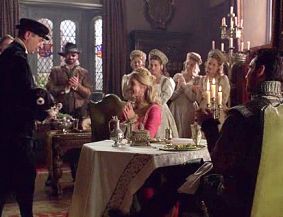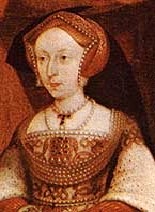Jane Seymour
Jump to navigation
Jump to search
Jane Seymour, Queen Consort as played by Anita Briem (Season 2) & Annabelle Wallis (Season 3)
Motto: " Bound to Obey and Serve"
UNFORGETTABLE CHARACTER QUOTES
DEFINING EPISODES | MEMORABLE SCENES
PHOTOS
Motto: " Bound to Obey and Serve"
| | |||||||||||
| Born c. 1508/1509 - married May 30th, 1536 - died of puerperal fever October 24, 1537 Character's backstory: Although Jane had been at court for more than 6 years having been a lady in waiting to both Queen Katherine of Aragon & Queen Anne Boleyn, Henry's interest was first recorded by Ambassador Chapuys in his letter of February 10th, 1536. In his previous letter of January 29th, he mentioned a rumour of a third marriage but as he then had no name & dismissed the tale even though from a "good authority'", the natural conclusion is that the matter was of fairly recent origin - indeed he termed it "une nouvelle amour" ( a new love). Within 3 months, Queen Anne would be beheaded & Jane would be betrothed to the King. As historian David Starkey wrote, Jane had just as much religious fervor as Anne Boleyn but it was the opposite sentiment: while Anne was a "radical reformer", Jane was a supporter of the institution of the Catholic Church. Jane did not have the stellar education of Queen Katherine or Queen Anne, in fact she could only read and write her name, which was typical for women of her station at the time. Her skills included needlework and household management. Gentility: daughter of a knighted courtier, is King Henry's fifth cousin three times removed Position: Lady in waiting to Queen Katherine of Aragon and then to Anne Boleyn Personality type: Strict & formal as queen. Quiet, meek, modest & seemingly compliant were the usual reports, although Imperial Ambassador Chapuys described her as "haughty." She took little interest in pageantry and active entertainment (unlike her predecessor) and was devout & punctilious in her religious observations. Signature look: Pale, doe eyed. Endearing trait(s): sincerity, honesty and genuine personality in the series, but historically wanted to be queen as much as Anne Boleyn did, loyalty (she had been a friend and lady in waiting to Katherine of Aragon, and pleaded with Henry for the reinstatement of Katherine's and Henry's daughter, Mary in the succession and her place at court in spite of Henry angrily telling her to look to her own future children. Although Jane pleaded for Mary's reinstatement, Henry insisted on her complete submission to his authority, both temporal and spiritual. An exhausted Mary complied, and upon her return to court, Jane befriended Mary and appointed her step-daughter godmother to her son Edward. Jane was also prudent unlike her predecessor, and chose her battles wisely. Annoying trait(s): is often criticized for being too docile, submissive, and a bit of a doormat, however she had flirted with the married King while his wife was pregnant. Scandals: Historians debate on whether she actively played a crucial and conscious role in the cold-blooded plot to bring Anne Boleyn to the scaffold. Her father John Seymour's affair with his son Edward Seymour's first wife also caused a great scandal, and seriously damaged the reputation of the Seymour family. It may have been for this reason that the proposed marriage between Jane and William Dormer was rejected by the Dormers. In 1536, was when she asked for pardons for participants in the Rebellion of the Pilgrimage of Grace. Henry is said to have rejected this, reminding her of the fate the other queens met with when they "meddled in his affairs". Buried: St. George's Chapel at Windsor Castle, her husband was buried next to her in 1547
|
"a woman of no family, no beauty, no talent and perhaps not much reputation" ~ David Starkey "one of the least remarkable women ever to play a part in history" ~ Marie Louise Bruce "....because Jane Seymour had a sympathetic nature, it did not mean that she was without conventional aspirations." ~ Antonia Fraser "Her conduct, first as a royal lady-in-waiting and later as a queen, indicates that she was more of a steel magnolia -a fragrant, seemingly fragile, ultra feminine exterior concealing a tensile core." ~ Leslie Carroll "A mediocre, an average woman; not exceptionally able not yet exceptionally foolish; neither fire nor ice; devoid of any vigorous wish to do good and of the remotest inclination to do evil; the average woman of yesterday, today and tomorrow." ~ Stefan Zweig (1881 - 1942)
Click EasyEdit to update this page! (Don't see the EasyEdit button above? <a href="/#signin" target="_self">Sign in</a> or <a href="/accountnew" target="_self">Sign up</a>.) | ||||||||||
CHARACTER CONNECTIONS Family members: Jane came from a large family of eight siblings, which gave King Henry encouragement of her potential to bear viable offspring, her brothers Edward and Thomas would continue to influence the Tudor monarchy until they were executed as traitors. Father: Sir John Seymour Mother: Margaret Wentworth Brother: John Seymour Brother: Edward Seymour Brother: Thomas Seymour Brother: Sir Henry Seymour Brother: Anthony Seymour Sister: Elizabeth Seymour (married to Sir Thomas Cromwell, Earl of Essex son Gregory) Sister: Dorothy Seymour Sister: Margery Seymour Sister-in-Law: Anne Stanhope Son: Prince Edward Tudor, King Edward VI (1547-1553) | Friends: Anne Stanhope (her brother's wife) Elizabeth Seymour (sister) Lady Mary Tudor Catholic faction led by Nicolas Carew and the Seymour family Enemies: Thomas Cromwell, Earl of Essex Thomas Cranmer the Boleyns the Howards LINKS:
|
UNFORGETTABLE CHARACTER QUOTES
|
DEFINING EPISODES | MEMORABLE SCENES
|
| For more on Jane Seymour - click on links below |
<embed flashvars="transition=Fade&site=http://www.thetudorswiki.com&imageServer=http://image.wikifoundry.com&albumId=44296" height="400" src="http://widget.wetpaintserv.us/wiki/thetudorswiki/widget/unknown/d8a71435ec5b9d229c9d830df52f5c5e907ced18" type="application/x-shockwave-flash" width="400" wmode="transparent"/> |
PHOTOS
| | Detail of The Whitehall Mural showing Jane Seymour) by Remigius van Leemput after Hans Holbein. 1667Royal Collection  detail of the portrait showing the puppy on Jane's skirt. |
Videos
| <embed height="280" src="http://widget.wetpaintserv.us/wiki/thetudorswiki/widget/youtubevideo/ec1f2022d9bb9d0c325c134fb9628b35b928cb67" type="application/x-shockwave-flash" width="340" wmode="transparent"/> | <embed height="281" src="http://widget.wetpaintserv.us/wiki/thetudorswiki/widget/youtubevideo/2526e44845883f7128f27e359735c26788f32cc9" type="application/x-shockwave-flash" width="343" wmode="transparent"/> |
| <embed allowfullscreen="true" height="279" src="http://widget.wetpaintserv.us/wiki/thetudorswiki/widget/youtubevideo/82045988c5725e5f37c42394fff2c04c5be78443" type="application/x-shockwave-flash" width="344" wmode="transparent"/> | <embed allowfullscreen="true" height="279" src="http://widget.wetpaintserv.us/wiki/thetudorswiki/widget/youtubevideo/5448073ca43b1b321c7172021436f46c43991823" type="application/x-shockwave-flash" width="344" wmode="transparent"/> |
